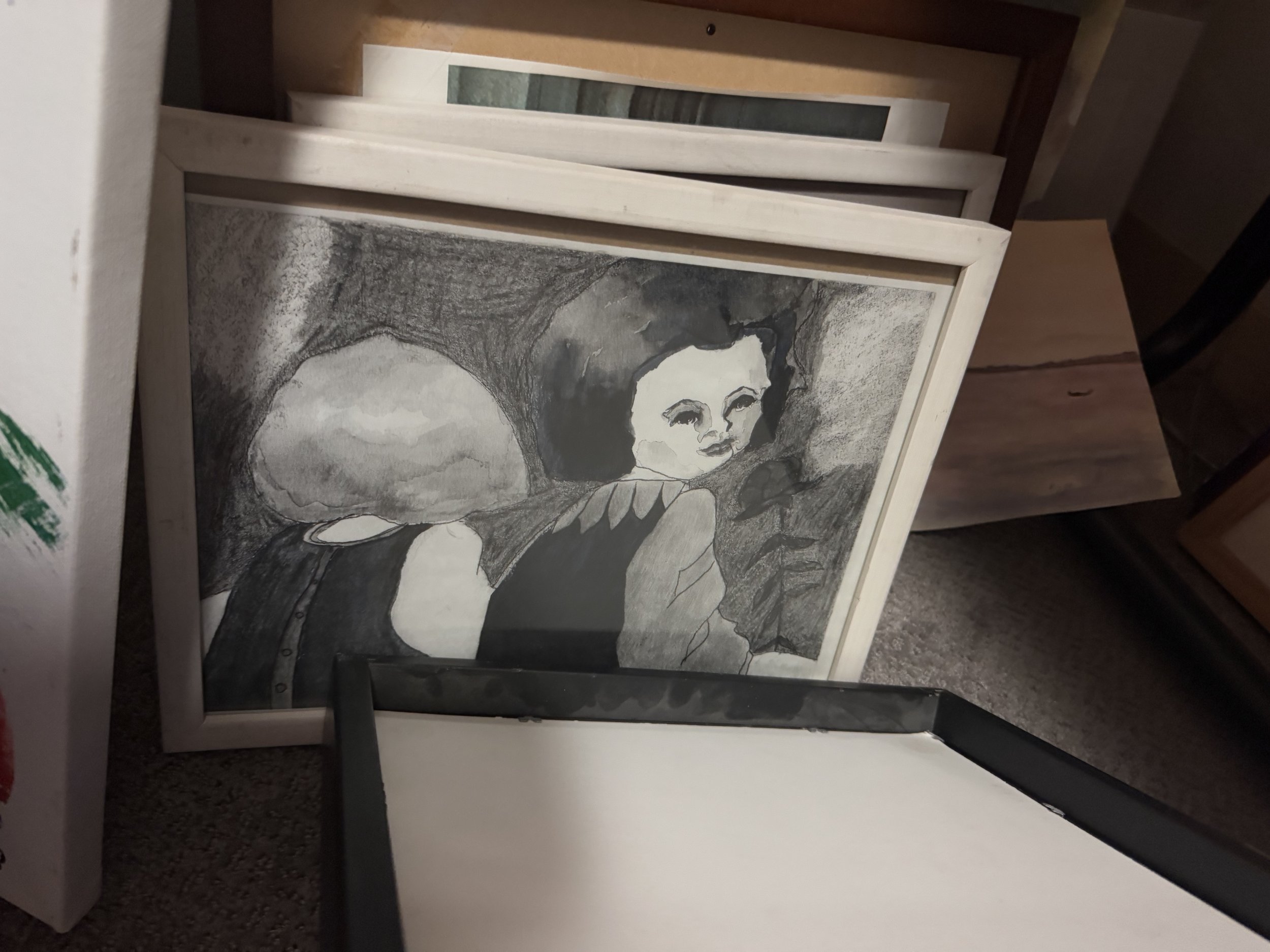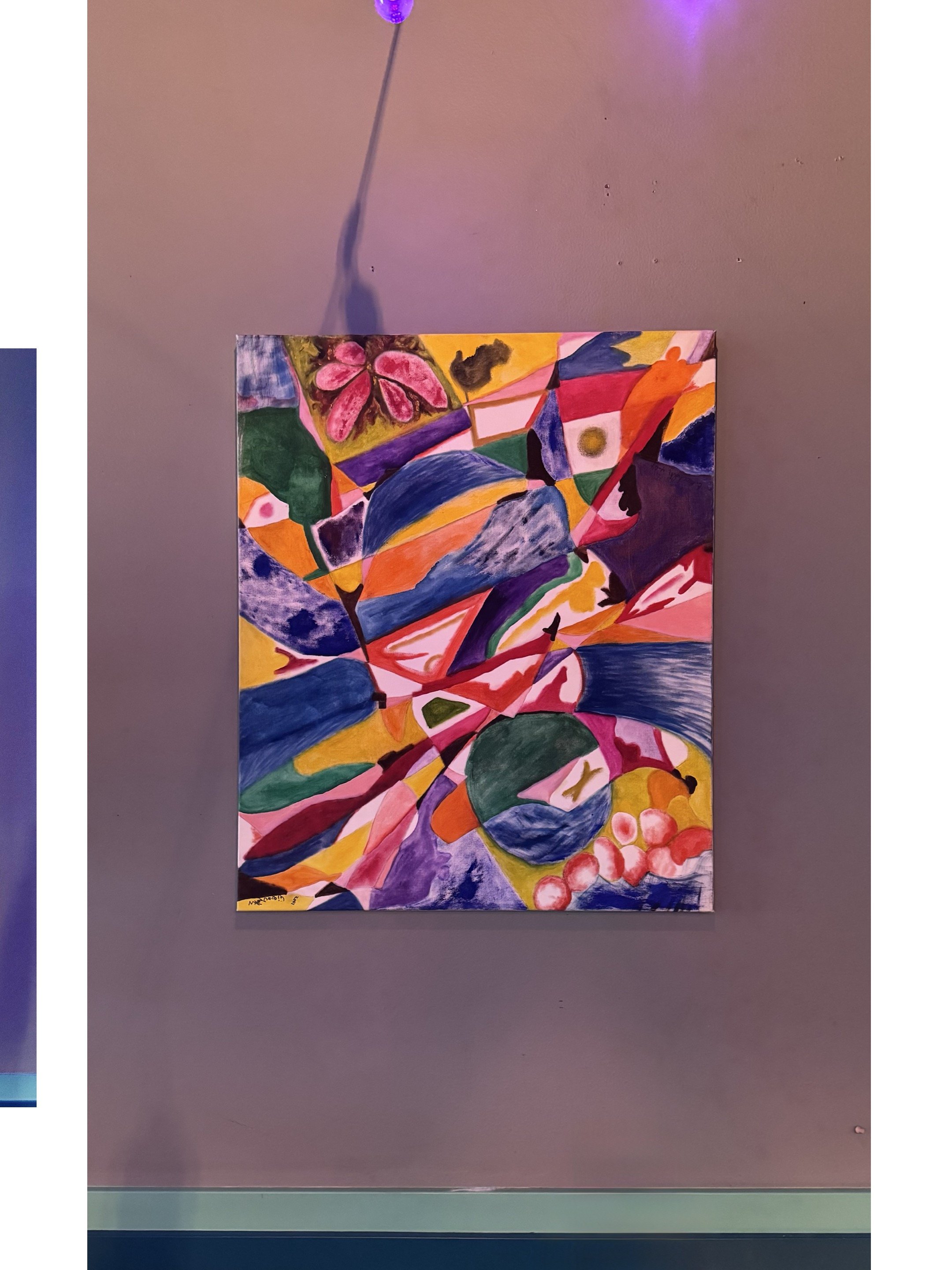Elinore Bucholtz and Other Abstract Painters
Elinore Bucholtz life’s work, for the most part, in her storage unit. Photo provided by the author.
Elinore Bucholtz is an eighty-six year old painter residing in Capitol Hill, Seattle, where her work has made an appearance in several local businesses like Kismet and Post Pike Bar & Cafe. On her own accord she reached out to these spots, the latter where I happen to curate the art on the walls. I was invited to visit her storage unit, which holds over two-hundred paintings and drawings that followed her from New York and have been produced in her current home studio. I hand-picked the work myself, carefully careening my body in the dense space to get a better look.
I am impressed with her undertaking and have read about her work written by Todd Matthews, a local journalist who published their interview in Capitol Hill Sea Seattle blog. Seattle Refined also interviewed her and featured her as an artist of the week. I enjoyed reading her direct, concise answers as to why she paints, in a style she describes as Abstract Lyricism—there are no other frills about her language. The freeness of her painting, a practice I learned she picked up in her late fifties, is refreshing to say the least.
If you know me personally, or have visited an art show with me in the past, I always have something to say — I can be very critical, yet always constructively. I am going to detour from my visit with Bucholtz to share some ideas I have around the context of the numerous micro-categories of “abstract” paintings endlessly on display, where my appreciation for Bucholtz’s matter-of-factness in her process begins and is bolstered.
This one is going to be different – this I a say to myself about the structure of this writing, however it is also what I imagine many contemporary abstract expressionists earnestly say to themselves when they embark on yet another lackluster painting. Two examples follow:
Diva Corp, an online, anonymous presence of raw art criticism based in Los Angeles, recently posted this to their story and I audibly laughed.
Screenshot of @divacorp_usa Instagram provided by the author.
Girl (Diva Corp is totally a girl to me), if I am reading into this question as being posed in a reproachful manner, I one-thousand percent agree. Why is it happening? Yawn. The sentiment of these paintings is sleepy. There is clearly a profundity to the artists in question here, romanticizing a wispy garble of gestures strewn over coffee stains; the kind of painting whose author finds it clever to “reveal” the raw canvas. The embedded meaning feels slippery and the strokes look egotistical. I see Diva Corp assessing on their Instagram the nature of trends in a more high-brow landscape of art, which is the context that I associate with these paintings. I am fully assuming they are of high monetary value. I can’t get with it. These dull expressions of nothingness straddle a space of capital “A” art world consumers and the average Michael’s Craft Store decor shopper. It is loveable to some types of an everyday consumer in extreme ways. I don’t know what style to call it. The over-saturation of the artworld with paintings cyclically breeds paintings like this. They look like someone zoomed in on a Romanticism painting and decided that was all the light and mark they needed. No one needs to reduce the paintings of that era.
The same day I witnessed this post, I saw these paintings announced by Taswira Gallery as their next solo exhibition.
2. Ariane Callender, Surrendering to Alchemy, on view for the month of March 2025.
Screenshot of works on view at Taswira Gallery provided by the author.
Screenshot of works on view at Taswira Gallery provided by the author.
I don’t want to come across as relentlessly pursuing this gallery, or derisively dogging these artists who I know must make work from a deeply personal place. My criticism of these styles of paintings follows both Diva Corp’s posturing and my intense feelings on the lack of substance on the surface of the works in Cristina Martinez’s exhibition To the ones who Remain Unbroken, which was shown the month prior at Taswira Gallery.
What is perpetually emerging to me is the importance of the story behind the work. In one painting analyzed on Taswira’s Instagram, it is described that Callender painted one piece to capture the vibrancy of her hometown, New Orleans. In another, the artist was preparing to have a baby and was experiencing new anxieties. And in another, there is an explanation that she was physically unable to stand after giving birth. My girlfriend, listening to my commentary while watching the Instagram reel alongside me, says, “I think my vagina looked a lot like that after giving birth.” I couldn’t tell if it was a compliment, but it was certainly a statement.
Part of what makes looking at art engaging (all of this goes without saying, in my opinion) is the ability to translate an intention or narrative in the work without the context of the story. The philosophical noodlings and grandiloquence language around amateur, overly-saturated tactics of mark-making does not make a painting “good.” Oftentimes I see adjectives crowded together in excess to subdue a lack of material investigation. Could we have less words, please?
Elinore Bucholtz with recent works in her home. Photo provided by the author.
Now that I have walked you through two contexts of abstract paintings in two different contexts of a gallery space, high tier and emerging, it is to be noted that the context of location plays quite a role in my analysis and appreciation of Elinore Bucholtz’s works. There is something raw and unpretentious about showing work in local businesses. It is a wonderful way to be interruptive to daily consumption. And my opinion of the art I witness does not evade the encouragement I hold for people to make art. What I love about Bucholtz is her authenticity in her paintings. It is a hard thing to measure with just the eye, though when I get to talking with the artist she plainly describes her art like this, “I never plan anything. Just as I’ve said, I put paint on the brush and on the canvas and take it from there.”
She tells me she pursued making art after taking classes for retirees at 56 (she darkly jokes this is almost impossible to do today). She is always pursuing the creativity of her capabilities. “I ended up taking workshops at the Art Students League in New York. No one there ever said, ‘oh, you've got talent, that looks good.’ So I figured it's all terrible, who cares?” That certainly has not deterred her from her work, as I hope any commentary or criticism I have for the aforementioned work doesn’t deter the makers from making.
Visiting Bucholtz’s home after her storage unit, and saw her studio quite literally overflowing with work, I said, “you have a lot of paintings in here!” It was hard not to suggest the following: “do you ever think to paint over the top of them?” It is a question I was asked during my time in my undergraduate studies for painting, instructed to not treat my paintings so preciously. I am often plagued by the suggestions of art school professors. However, Since Bucholtz is bursting at the seams with her work, which ends up in the storage unit if not hung elsewhere, I thought it might be a helpful suggestion. I probe further, “is that a suggestion that resonates with you?”
Elinore Bucholtz’s home studio. Photo provided by the author.
“No, it doesn’t connect to me,” she dryly responds. Fair enough.
Maybe she took offense to what I suggested. I clarified that I work in a similar way; I frequently take work apart, have thrown things away (to my demise) and re-contextualize work that doesn’t do what I want it to do. The work isn’t terrible because of these things. And certainly she is not afraid of making a terrible painting, either.
I find her work to be quite investigative. She spends her time thinking of shape and color. In my mind, I see more dynamism in her work than the previously dissected works above. I am having a conversation with someone who doesn’t bother mixing paints, or covering up work; uninhibited by the mess of art school speak and critique.
She tells me, “[painting] is just what I do. You know, I'm retired many years. I'm not busy with all kinds of stuff. My son has grown up and married. I don't have to worry about him. This is one of the things that I do [she pauses] during my life. I don't know how else to put it.”
I even ask her about her inspiration through other artists. I wanted to know if she read about other artists, looked at other paintings, spent time in museums often. She does love the Seattle Art Museum and the Asian Art Museum, and used to love visiting museums in New York and spending time with Impressionist paintings when she was more mobile. “Has it always been that way? Like, since you started your painting journey, do you feel like you've always been a little bit more internal as to where your inspiration comes from?”
A graphite drawing from New York tucked away in a dense stack of framed works. Photo provided by the author.
“Yeah. Since I didn't… go to art school, take classes which taught you how to do this, that or the other, I had to think of it myself.”
“Do you have a favorite painter or artist?”
“No. No, because there are individual paintings by many different people that I like.” Truthfully, she tells me, “I don't even think about what other people do.”
How I wish it were easy to me to not think about what other people do. The generational gaps between us and ways in which we found art in our lives put aside, I believe we both learned so much from each other in the hours we spent in her storage unit, hanging her work on the walls of Post Pike, and visiting her home studio. Since the time of our conversation she is in talks of having her work acquired by the building she dwells in, and continues to put her work in front of a nearby gallery in hopes they might exhibit them. Her work will always be seen and enjoyed as long as she can help it. I read in one of her interviews that a psychic told her she was going to live to be one-hundred and five years old. So, she has plenty of time.
Pictured below: Elinore Bucholtz’s works hanging at Post Pike Bar & Cafe from January 17th to March 24th. Thank you to Elinore for sharing your work and time with me. Keep going.














